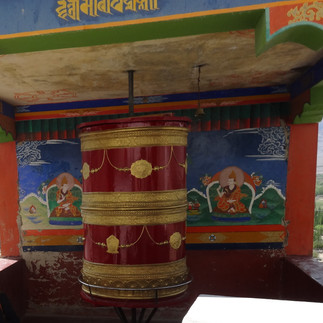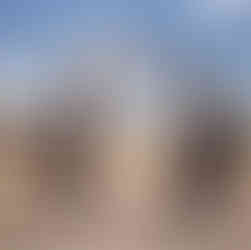Ladakh with its capital at Leh can easily be called any traveller's dream destination.
About Ladakh
In a short trip of 7 to 8 days, one can see beautiful vistas of snow-capped mountains, emerald blue lakes, lusty rivers, gravity-defying mountainous roads, cold sand deserts, old palaces and Buddhist monasteries and so many other wonders of nature. Hard to believe? But it's true!
The Union Territory of Ladakh lies at an elevation of 6000 m. The quickest way to reach Ladakh is to fly directly to Leh's capital city.
The problem with flying directly to such a high altitude is that it can cause severe altitude sickness with symptoms like dizziness and headaches. If you're travelling by road, then your body gets time to acclimatize gradually which in this case happens suddenly.
If you've hired a tour operator, they will leave your day of arrival in Leh free to give your body a chance to acclimate to the altitude.
This is an absolute must before you embark on your Ladakh adventure.
A few more things to keep in mind before travelling to Leh are -
One, an Inner Line permit or ILP is required to visit some places in Ladakh. Restricted Area Permit or RAP is required for other places close to Siachen or LOC. We visited Ladkah in 2014, and none of these permits were needed at that time. Your tour operator should ensure all permits are in place before the journey.
Two, Ladakh is a desert, it can be very hot during the day when the sun is shining and it can get quite cold at night. So, while travelling outdoors, always wear clothes in layers and carry a jacket.
Three, altitude sickness is real. It can cause severe dizziness and discomfort in some people. Please ensure that you carry medicines that you think might be needed to combat this problem.
Four, there can be some last-minute delays and cancellations in flights to Leh because of weather conditions in Leh. If you're travelling with kids and seniors in your family, then be prepared for some hardships. Carry drinking water and snacks for such eventualities. In peak season, the crowds are really heavy and delays could occur because of that.
We visited Leh in June 2014, the Indian Government had instructed the airlines to reduce their passenger load owing to safety concerns about landing at the high altitude in Leh. We had to endure a lot of difficulties and delays flying in and out of Leh.
However, once you've landed the stunning landscape of Leh will mesmerize your senses....
Day 1
Check-in at the hotel and a complete day of rest and acclimatisation.
Day 2
Thikse Gompa
After a full day of rest on arrival, we ventured out into the beautiful landscape to visit Thikse Gompa or Monastery on Day 2.
The monastery is about 19 km from Leh and the route to the monastery was through a beautiful road with views of snow-clad peaks.

Thikse Monastery is a massive structure built atop a hill with stunning views of the Indus Valley. On first look, the monastery gives a very familiar feel owing to its resemblance to the Potala Palace in Lhasa whose pictures one might have seen on many travel sites.
The main attraction of the monastery is Maitreya Buddha, a 15m high copper and clay statue of Lord Buddha that reaches up to two storeys. There is a long winding staircase that runs through the monastery.
An arcade with a giant rolling drum fixed to its ceiling is the first attraction.
Apart from this, there are temples, an assembly hall, smaller drum rolls with colourful Buddhist inscriptions, a beautiful courtyard with multicoloured arches, and the monastery rooftop with stunning views of the valley all around.
The place oozes a sense of calm and one can easily spend about two to three hours basking in the serene surroundings of the monastery.

The giant drum roll and colourful facades and amazing views from the monastery rooftop!
Shanti Stupa
After spending about two hours in the monastery, we headed to 'Shanti Stupa'. It's a short ride from the monastery amidst beautiful scenic mountains that are so integral to any road trip in Leh.
The Stupa is a pristine white dome structure built on a mountain facing the Leh Palace by Japanese Buddhists in 1991 to promote world peace.
My Tip -
The thing to remember is that one has to climb 500 steps to reach the entrance to the Stupa. So wear comfortable shoes for the climb. The views of the valley from the top are spectacular and worth the climb! There is also a nice cafe for refreshments.

Old Town
From Shanti Stupa, we travelled to the Old Town in Leh to the 17th-century Leh Palace. This was the residence of the royal family of Ladakh. The palace is in a dilapidated condition but the large wooden balconies and impressive facades tell tales of the glory of the past.
Day 3
Hall of Fame
After breakfast, we headed to the 'Hall of Fame', the war Museum in Leh constructed by the Indian Army.
It's dedicated to the soldiers who fought in the Indo-Pak wars.
The museum showcases the way soldiers live in the Siachen glacier, what they eat, the tents where they live, the weapons they use and many other interesting artefacts. There is an entire wall displaying photos of the Kargil War and a documentary on 'Operation Vijay' in the projection room.
My Tip -
If you're travelling with kids, this will surely be a fun outing for them. There is also a small adventure park for kids. My boys were thrilled to see army tanks on display and the many adventure activities in the park.

Most tour operators also give you a tour of the local market in Leh, take you to some shopping areas and show you some local attractions, especially places where some films have been shot. Again, if you're travelling with kids, they would be thrilled to see such 'hotspots'.
A backdrop of the Hindi film '3 Idiots'
Magnetic Hill
After an adventure-packed morning, we went to another thrilling activity of the day, 'Magnetic Hill'. This site is at a distance of 30 km from Leh.

The mountain is known to defy gravity since your car, with its engine, switched off, will appear to be going uphill instead of downhill. This strange phenomenon was met with squeals of delight from all of us.
Zanskar River
The thrill continued on Day 3 with our journey to the confluence of the Zanskar and Indus rivers, called Sangam, in Nimmu Valley, 35 km away from Leh on the road towards Kargil.
The spectacular merging of these two mighty rivers is a sight to behold with two distinct streams of colour forming one before flowing away into the mountains.

View from the top!
Day 4
Pangong Lake
Early morning, we set out for Pangong Lake which is about 160 km away. Please remember that this trip requires you to carry an ILP. The road trip takes about 6 - 7 hours, over the beautiful Chang-La, which is counted among some of the highest passes in the world.
The roads are good and the route to reach Pangong is as beautiful as the destination. This was a full-day outing and definitely a high point of our Ladakh trip.

En route to Pangong......first glimpse of the lake!

The mesmerizing Pangong Lake!
My Tip -
Plan to stay longer, the lake appears to change colours as the day progresses and offers some amazing photo opportunities. We came back in the evening, exhausted but rejuvenated from this outing.
Day 5
Nubra Valley and Khardung-La Pass
The trip to Nubra Valley is an overnight excursion via the Khardung-La pass, which is the highest motorable road in the world at a staggering height of 18832 ft above sea level.

Awe-inspiring .....desert, mountains, rivers, sand, vegetation, even snow and a glorious sunset in the Nubra Valley!
The 5-hour journey goes through some beautiful topography and picturesque mountain scenery. There is a stop at Khardung-La for photos and some light refreshments.

My Tip -
The condition of the road initially is quite good but from South Pullu to Khardung Peak, the road becomes bumpy and bad. Please carry your medicines if you have a medical condition that could get worse by such a hectic road journey.

Things to note are that Nubra is a valley, so it's less cold than Leh. Avoid carrying very heavy woollens.
Dressing in layers is your best bet as it can get cold at night.
Overnight staying facilities are tented, so carrying toilet paper and some other toiletries is a must.
Although, tented accommodation has very good nets to keep mosquitoes and insects at bay, but you should carry some mosquito repellant.


Stunning vistas at the Nubra Valley...
Nubra is unbelievably stunning. There is a cold desert, sand, some scanty vegetation, a river flowing by, and snow-covered peaks all together in one place. We waited for the sunset behind the mountains and the effect was magical.
The next day, Day Six of our journey, we started back for Leh. By late noon, we were back in our hotel after this exhilarating outing.
We decided to spend the last evening of our trip exploring the local market which is replete with shops of souvenirs and local handicrafts.
Our trip to Ladakh came to an end but the memories of this enchanting land live on in our minds!












Comentários